 Sexual
or Erotic Films focus
on themes with either suggestive, erotic or sensual scenes or subjects, sometimes
with depictions of human nudity and lovemaking, but not always of an extremely
explicit, gratuitous or pornographic nature. These kinds of films often appeal
to the emotions of the viewer, with their emphasis on pleasure, physical desire,
and human companionship. Films of romance with heart-throb sexy lead characters may have sexual elements, but these
are often secondary to the main plot goal - the search and attainment of love. Sexual
or Erotic Films focus
on themes with either suggestive, erotic or sensual scenes or subjects, sometimes
with depictions of human nudity and lovemaking, but not always of an extremely
explicit, gratuitous or pornographic nature. These kinds of films often appeal
to the emotions of the viewer, with their emphasis on pleasure, physical desire,
and human companionship. Films of romance with heart-throb sexy lead characters may have sexual elements, but these
are often secondary to the main plot goal - the search and attainment of love.
In the days before the film industry's stringent Production
Code was established in 1930 (known as the Hays Code after Will Hays, the head of the Motion Picture
Producers and Distributors of America - MPPDA) and
strictly enforced after 1934 to regulate "morally offensive" content,
many silent and 'Pre-Code' taboo-breaking films contained adult-oriented material.
In addition to nudity, sexuality and violence, they included candid depictions
of drug use, prostitution, lawlessness, and religious blasphemy.
Since the abandonment of the Hays Code in the late 60s, and
the fairly recent establishment of various rating systems, sexual or erotic
films with even small amounts of nudity have become more abundant. They often
include frank adult content, violence and explicit language, or just suggestions
of eroticism or sensuality. Teen sex comedies, erotic dramas or thrillers,
sexploitation films, and other films dealing with sexual content are included
in this wide-ranging category.
The Earliest Films:
Shortly after the Lumieres conducted
the first public screening of a film (in December 1895), pioneering
French film-maker Georges Melies directed the very short B/W 'adult' film Après Le Bal (1897, Fr.) (After the Ball, Bath) with one of
the earliest nude scenes in film history. Reportedly
around the same time, "blue movie" pornographer Eugene Pirou pioneered
the risque film (called "smoking concert" or stag party films) when
he produced the slightly erotic Le Coucher de la Marie (1896, Fr.) (aka Bedtime for the Bride) in which Louise Willy
performed the first strip tease onscreen during a bathing scene -- the short pornographic film (of which only a few minutes exist) was directed by
Léar (real name Albert Kirchner).
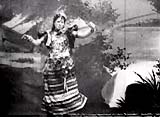 Another similar film was Fatima’s Coochie-Coochie Dance (1896) a short nickelodeon kinetoscope/film of
a gyrating belly dancer named Fatima (well-known for her dancing shows at the Columbia
World's Exhibition in 1893). It became the first film in which a scene was
censored - for her gyrating and moving pelvis - it was covered up by what
appeared to be a white picket fence (a grid-like pattern of white lines). Another similar film was Fatima’s Coochie-Coochie Dance (1896) a short nickelodeon kinetoscope/film of
a gyrating belly dancer named Fatima (well-known for her dancing shows at the Columbia
World's Exhibition in 1893). It became the first film in which a scene was
censored - for her gyrating and moving pelvis - it was covered up by what
appeared to be a white picket fence (a grid-like pattern of white lines).
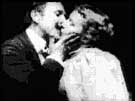 The
very first kiss on film was between a Victorian couple seen in the
Edison kinetoscope The May Irwin Kiss (1896) (aka The Kiss,
or The Irwin-Rice Kiss in a filmed scene from the stage play The
Widow Jones). This titillating short 20-second film, with a close-up of
a kiss, was denounced as shocking and pornographic to early moviegoers and
caused the Roman Catholic Church to call for censorship. The
very first kiss on film was between a Victorian couple seen in the
Edison kinetoscope The May Irwin Kiss (1896) (aka The Kiss,
or The Irwin-Rice Kiss in a filmed scene from the stage play The
Widow Jones). This titillating short 20-second film, with a close-up of
a kiss, was denounced as shocking and pornographic to early moviegoers and
caused the Roman Catholic Church to call for censorship.
And Eadweard Muybridge's primitive motion studies (from 1884-1887)
included test footage with cinematic glimpses of naked men and women. Lois
Weber's and Paramount's 4-reel silent film Hypocrites (1914) featured
full female nudity in the guise of an unclad lady (Margaret Edwards) - 'the
Naked Truth' - who occasionally appeared as a transitional plot element between
scenes.
Audrey Munson (a real-life model) first appeared artistically
nude in George Foster Platt's controversial Inspiration (1915) from
the Mutual Film Corporation, as a sculptor's model. It was the first known film in which a leading actress stripped down to be naked, making her the first nude film star. Munson also appeared nude
in another silent film, Rea Burger's 7-reel Purity (1916), in a dual
role as a spirit figure and as an artist's nude model named Purity/Virtue.
Theda Bara: The Vamp and First Sex Symbol
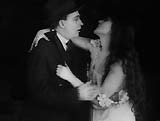 Sex
was portrayed in the earliest films as something exotic and foreign. The original
vamp and first movie sex goddess, the full-bosomed Theda Bara, starred
in a number of early silents for the Fox Film Corporation - her first lurid,
slinky vamp appearance (and first lead role) was in Fox's melodramatic A
Fool There Was (1915), in which she portrayed a worldly, predatory woman
who stole a married man away from his wife and child. Her most famous line
in this film was: "Kiss me, my Fool!" Sex
was portrayed in the earliest films as something exotic and foreign. The original
vamp and first movie sex goddess, the full-bosomed Theda Bara, starred
in a number of early silents for the Fox Film Corporation - her first lurid,
slinky vamp appearance (and first lead role) was in Fox's melodramatic A
Fool There Was (1915), in which she portrayed a worldly, predatory woman
who stole a married man away from his wife and child. Her most famous line
in this film was: "Kiss me, my Fool!" 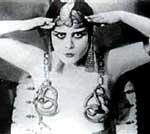 She became known as "the
wickedest woman in the world." Although she played
other non-vampish roles, her vamp appearances were destined to be the most
lucrative. She became known as "the
wickedest woman in the world." Although she played
other non-vampish roles, her vamp appearances were destined to be the most
lucrative.
Other suggestive, femme fatale vamp roles were in Herbert Brenon's Sin
(1915), The Devil's Daughter (1915) - her third vamp film, and
in The Tiger Woman (1917). She was also most notably seen nearly nude
with the contours of her breasts held by two curving gold asps in her first film made in Hollywood - the very successful Cleopatra (1917). Bara's
'come-back' picture, The Unchastened Woman (1925), was a remake of
an earlier 1918 film. [Most of Bara's films, however,
are currently unavailable because few of the film prints have survived.]
Other Early Silent Films and Their Sexy Film Stars:
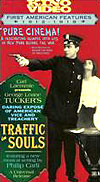 For the most part, the silent years were not known
for explicit sexual content. However, there were some exceptions: For the most part, the silent years were not known
for explicit sexual content. However, there were some exceptions:
- the first American feature-length sex film was Traffic in Souls (1913) (aka While New York Sleeps) - it was a "photo-drama" expose
of white slavery at the turn of the century in NYC, although the film exploitatively
promised steamy sex in its advertisements; this was one of the first films
to understand that 'sex sells' although its producers worried that a 'feature-length'
film wouldn't be successful; another vice film with the same historical
theme of revealing the world of prostitution was The Inside of the White
Slave Traffic (1913); Damaged Goods
(1914) and The Sex Lure (1916) were similar melodramatic, "exploitation"
films advertised as containing the "Shocking Truth"
- A Free Ride (1915) (aka A Grass Sandwich) was reportedly the earliest-known
US silent stag ('men only') or pornographic film - with explicit sex scenes of a wealthy man picking up two females with his model-T and then having sex with his hitchhikers by the side of the road. Its comic titles foretold its plot: Directed by A. Wise Guy, Photographed by Will B. Hard, and Titles by Will She. Because these kinds of films (with increasingly explicit amounts of nudity and sexuality) were completely illegal, they were shown in all-male locations, clubs, etc., not in mainstream theaters
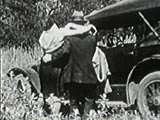 Australian-born swimming and diving champ Annette Kellermann
(the "Esther Williams of the silent era") caused a stir when she
was seen naked with her flowing hair under a waterfall in director Herbert
Brenon's and Fox's fairy-tale Daughter of the Gods (1916) - she was
the first major female star to appear nude on screen (see also the next item) Australian-born swimming and diving champ Annette Kellermann
(the "Esther Williams of the silent era") caused a stir when she
was seen naked with her flowing hair under a waterfall in director Herbert
Brenon's and Fox's fairy-tale Daughter of the Gods (1916) - she was
the first major female star to appear nude on screen (see also the next item)
- in the same week, another female lead appeared nude for
the first time in a feature film on screen - 16 year-old blonde starlet
June Caprice (a Mary Pickford look-alike), in Fox's melodramatic Cinderella tale The Ragged Princess (1916), who appeared in a prolonged, nude
swimming sequence
- director D. W. Griffith threatened
virginal and innocent Lillian Gish's defilement in the controversial The Birth of a Nation (1915), and his extravagant set of Babylon
in Intolerance (1916) included half-naked, lightly-draped women
in love temples
- in Jack Conway's The Penitentes (1916), fanatical
Roman Catholics staged actual crucifixions on Good Friday, with one crucifix
holding a nude girl
- director Richard Oswald's film Anders als die Andern
(1919, Germ.) (aka Different From the Others) was reportedly the first
representation of male homosexuality ("the third sex") in a feature-length
film, and the first screen depiction of a gay bar (with gay males and butch
females); the two ill-fated lovers were prominent pianist Paul Korner (Conrad
Veidt) and his young music student, Kurt (Fritz Schulz); the film had a
tragic ending (suicide for Korner) due to the effects of blackmail (threats
of exposure), jail time for violating anti-homosexuality statutes, and the
social stigma of being outed
- Cecil B. DeMille's Male and Female (1919) included
Gloria Swanson's notorious, half-clad disrobing scene in preparation for
a lavish bath in a sunken tub
- Yvonne Gardelle appeared naked as temptress demon-wife Lilith to Adam in a
pantomimed Garden of Eden prologue sequence in The Tree of Knowledge (1920), directed by Cecil B. DeMille's brother William; press kit materials tauted: "An old legend says that the tempter in Eden was not a serpent, but a beautiful women, Lillith, the demon wife of Adam before Eve was created"
- nude bathing/swimming scenes were evident in The Isle of Love (1918) (recut and re-released in 1922) and The Branding
Iron (1920)
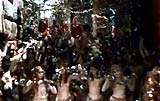 Rudolph Valentino wowed audiences as a passionate Latin lover with his portrayal of a dashing Arabian sheik in romantic fantasies including The Sheik
(1921), Blood and Sand (1922), and Son of the Sheik (1926) Rudolph Valentino wowed audiences as a passionate Latin lover with his portrayal of a dashing Arabian sheik in romantic fantasies including The Sheik
(1921), Blood and Sand (1922), and Son of the Sheik (1926)
- in Fred Niblo's Ben-Hur: A Tale of the Christ (1925),
in two-color Technicolor, a remarkable segment showed rows of bare-breasted
flower girls dancing in a pageant/procession as they tossed flowers to the
crowd lining the street
- a decadent orgy scene and semi-nude musicians in Erich
von Stroheim's silent operetta The Merry Widow (1925), and the sexually-excessive
depiction of a wickedly-decadent Queen Regina in von Stroheim's tawdry,
grotesque and fragmentary film Queen Kelly (1929)
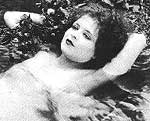 screen lover John Barrymore starred in Don Juan (1926) with Mary Astor and
Estelle Taylor, a film with a record number of kisses (reportedly 127) screen lover John Barrymore starred in Don Juan (1926) with Mary Astor and
Estelle Taylor, a film with a record number of kisses (reportedly 127)
- romantic lead John Gilbert (the sexy successor to Rudolph
Valentino) played opposite exotic vamp Greta Garbo in her star-making film Flesh and the Devil (1926)
- Lili Damita, Hope Hampton, and Sue Carol all briefly appeared in
the nude in respectively - Michael Curtiz' Red Heels (1925, Austrian) (aka Das Spielzeug von Paris), the melodramatic Lover's Island (1925), and the lost film In
Line of Duty (1931)
- flapper icon Clara Bow, dubbed the "It" girl during the
20s and one of the earliest sex symbols, appeared nude as Hula Calhoun in
an opening bathing scene, and performed a sexy hula dance, in the romantic comedy Hula (1927)
- American actress Louise Brooks was featured as an amoral
and insatiable cabaret star/prostitute Lulu in G. W. Pabst's classic German
silent film melodrama Pandora's Box (1929, Ger.) with blatant sexual
themes, a memorable lesbian dance/tango scene with Countess Anna Geschwitz
(Alice Roberts) during Lulu's wedding party, and her murder by the infamous
'Jack the Ripper' killer with a gleaming knifeblade stuck into her stomach
during an erotic embrace
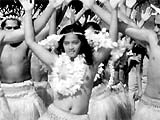 actress
Kay Johnson starred as a wicked woman in Cecil B. De Mille's bizarre Madam
Satan (1930) - a film that challenged the code with a racy party sequence
aboard a zeppelin actress
Kay Johnson starred as a wicked woman in Cecil B. De Mille's bizarre Madam
Satan (1930) - a film that challenged the code with a racy party sequence
aboard a zeppelin
- German expressionistic director F. W. Murnau's last film
(co-scripted with pioneering documentary film-maker Robert J. Flaherty)
presented a lush tale of ill-fated native South Seas love (with flower-garlanded,
bare-breasted native dancers) and the breaking of a sexual tabu (filmed
entirely on location in Tahiti) - a very-late black/white silent film Tabu:
A Story of the South Seas (1931) - and an Oscar-winning effort for Floyd
Crosby's cinematography
The 'Naughty' Pre-Code Days:
Censorship bills were introduced in many states and localities - but the vast complexity of various local, state and national censorship laws added to the problem of enforcement, i.e. in some states an ankle couldn't be displayed, or pregnancy couldn't be mentioned. In 1922, the Motion Picture Producers and Distributors of
America (MPPDA) was formed by the studios. Conservative former Postmaster General William H. Hays was appointed to head the organization, to begin efforts to clean up the motion picture industry before the public's anger at declining morality depicted in films hurt the movie business. One of his first acts in 'cleaning-up' Hollywood, due to pressure from Hollywood's top film executives, was to banish the acquitted actor-comedian Roscie "Fatty" Arbuckle from film, at least temporarily, in order to distract the public. [Arbuckle would continue to make films as a director under the pseudonym William Goodrich between 1925 and 1932.] Hays also approved the use of morality clauses in the standard actor's contract, to control the conduct of performers.
The Hays Office, with restrictions and guidelines on movie
content to establish "correct standards of life," issued a self-regulating
list of "Don'ts' and 'Be Carefuls' for film-makers in 1927. The following were targeted and specifically to be avoided:
- suggestive nudity
or perversion
- lustful kissing
- miscegenation
- criminal murder
- drugs
- brutal
violence, rape or attempted rape
- cruelty to animals and children
- racial
slurs or anti-government diatribes
- a man and woman in bed together
- deliberate
seduction of girls
- profane swearing
- capital punishment (hangings or
electrocutions)
Most studios basically ignored the regulatory restrictions,
because there was no enforcement that was effective, and they
knew that film-going audiences wanted to see the kinds of things
(sex and crime) that were being blacklisted. Many times,
studios would circumvent problems with the new restrictions by wrapping up
a film filled with sex and sinning with a quick climactic scene of moral repentance.
Some of the
illicit behaviors could be exhibited -- if later punished within
the film. Other film-makers avoided censorship by changing the titles of plays forbidden
to be adapted into films. One of the major difficulties with the repressive
code was that it was open to varying interpretations. Hays assured state and local censorship boards that he would properly regulate the industry.
Two Female Challengers to Film Morality:
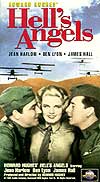 A number of notable and successful films produced
in the early 30s before the Code was strictly enforced -- so-called
"bad girl" movies -- showed women using their sexuality
to get ahead, such as in the taboo-breaking comedy Red Headed
Woman (1932) starring Jean Harlow. A number of notable and successful films produced
in the early 30s before the Code was strictly enforced -- so-called
"bad girl" movies -- showed women using their sexuality
to get ahead, such as in the taboo-breaking comedy Red Headed
Woman (1932) starring Jean Harlow.
Jean Harlow
One
of the earliest sex stars of the silver screen was smart-mouthed, 18-year
old platinum blonde Jean Harlow, who shocked audiences as a sexy floozy with
generous glimpses of flesh and her famous line of dialogue - "Would you
be shocked if I put on something more comfortable?" - in her first major
role in Hell's Angels (1930). In Goldie
(1931), she was noted as the first woman specifically referred to as a
"tramp" in a talking picture. She also appeared as an adulteress
in Red-Headed Woman (1932), and had a starring role as a stranded,
wise-cracking floozy opposite Clark Gable and a bourgeois, middle-class Mary
Astor in a tropical, steamy setting in Red Dust (1932) - Harlow was best seen bathing in a rain barrel. She has often been acknowledged
as the first screen actress to place erotic emphasis upon her breasts in a
time when flat-chested women were the rage.
Marlene Dietrich
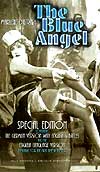 In
a number of films made by obsessed, Svengali-styled mentor/director Josef
von Sternberg, Marlene Dietrich played seductive, cool females in sexually
perverse melodramas. She was Lola Lola, a cheap, smoky-voiced, sensual cabaret
singer with stockinged-legs and top hat atop a beer barrel in the Blue Angel
nightclub in her greatest film, The Blue Angel (1930), Germany's first
sound film. In the atmospheric, seedy film, she manipulatively lured a repressed
and obsessed Professor Emmanuel Rath (Emil Jannings) towards his doom by her
teasing exoticism while singing Falling In Love Again. In
a number of films made by obsessed, Svengali-styled mentor/director Josef
von Sternberg, Marlene Dietrich played seductive, cool females in sexually
perverse melodramas. She was Lola Lola, a cheap, smoky-voiced, sensual cabaret
singer with stockinged-legs and top hat atop a beer barrel in the Blue Angel
nightclub in her greatest film, The Blue Angel (1930), Germany's first
sound film. In the atmospheric, seedy film, she manipulatively lured a repressed
and obsessed Professor Emmanuel Rath (Emil Jannings) towards his doom by her
teasing exoticism while singing Falling In Love Again.
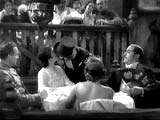 And
she scandalously wore a men's tuxedo in Morocco (1930) and accepted
both a rose and a mouth-to-mouth kiss from a young lady in the cabaret audience
- one of the earliest (if not the first) female-to-female kisses. In the highly-stylized Blonde Venus (1932), she performed a cabaret striptease from her full-bodied
gorilla suit and then donned a bushy Afro blonde wig to sing "Hot Voodoo"
in a throaty, hoarse voice to the beat of an African drum ("...That African
tempo has made me a slave, hot voodoo - dance of sin, hot voodoo, worse than
gin, I'd follow a cave man right into his cave"). Adultery and sadomachism
were evident in the unusually frank and suggestive The Scarlet Empress
(1934), in which Dietrich played Catherine the Great. And
she scandalously wore a men's tuxedo in Morocco (1930) and accepted
both a rose and a mouth-to-mouth kiss from a young lady in the cabaret audience
- one of the earliest (if not the first) female-to-female kisses. In the highly-stylized Blonde Venus (1932), she performed a cabaret striptease from her full-bodied
gorilla suit and then donned a bushy Afro blonde wig to sing "Hot Voodoo"
in a throaty, hoarse voice to the beat of an African drum ("...That African
tempo has made me a slave, hot voodoo - dance of sin, hot voodoo, worse than
gin, I'd follow a cave man right into his cave"). Adultery and sadomachism
were evident in the unusually frank and suggestive The Scarlet Empress
(1934), in which Dietrich played Catherine the Great.
|
